Contact us for quotation
Let's have a chat
Let's have a chat
LED technology has revolutionized lighting recently, becoming the go-to solution for energy-efficient and versatile illumination. From homes and offices to automotive and industrial applications, LEDs have reshaped how we light our surroundings. One of the key factors driving this revolution is the ability to control LED brightness precisely, extending functionality and energy savings. At the heart of this control is a technique known as Pulse Width Modulation (PWM) dimming, a method that provides seamless and efficient LED brightness adjustment.
LEDs, or Light Emitting Diodes, have come a long way since their introduction in the 1960s. Initially limited to essential indicator lights with low light output, LEDs now offer high-brightness solutions that surpass traditional incandescent and fluorescent lighting in terms of efficiency and longevity. The evolution of semiconductor materials and advancements in LED manufacturing have given rise to LEDs capable of producing a broad spectrum of colors and intensities, transforming how we use lighting in various environments.
One of the most significant breakthroughs in LED technology has been the development of dimming capabilities. Unlike conventional light sources that dim by reducing voltage, LEDs require more sophisticated control to achieve smooth and flicker-free dimming. This led to PWM dimming, which allows precise control over LED brightness while maintaining energy efficiency and color accuracy.
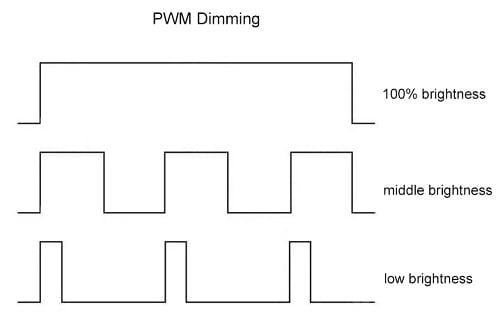
Pulse Width Modulation (PWM) dimming is a method that involves rapidly switching the LED on and off at a frequency high enough that the human eye perceives a continuous light. By adjusting the “on” time” (“duty cycle)”re” act “ve” to the “off” to”e w”thin each”cyc”e, “WM ” Imming controls the brightness of the LED without altering its color temperature or efficiency. For example, if an LED is on 50% of the time and off 50% of the time, it appears to be at half brightness.
PWM dimming is essential because it provides precise control over light intensity without sacrificing the LED’s performance. UnlLED’s dimming can cause LEDs to change color and efficiency when dimmed, but PWM dimming maintains consistent color quality and efficiency. This method is critical in settings where lighting precision and quality are crucial, such as architectural lighting, theatrical lighting, medical devices, and intelligent lighting systems.
Moreover, PWM dimming contributes to LED lighting’s saving benefits. Switching the LEDs on and off rapidly consumes less power, resulting in lower electricity costs and extended LED lifespan. Additionally, PWM dimming enables compatibility with advanced control systems, including smart home automation, making it a preferred choice for modern lighting solutions.
This article is an in-depth exploration of PWM dimming, its advantages, and its application in LED lighting systems; by understanding how PWM dimming works and its benefits, you’ll byou’ller equipped with syou’llthe most efficient and versatile lighting solutions for your needs.
In this blog post, we will cover the following key aspects:
By the end of this article, you will have a comprehensive understanding of PWM dimming and how it enhances LED lighting systems, allowing you to make informed decisions when selecting LED products. Whether you are a homeowner looking to create the perfect ambiance or a professional seeking advanced lighting control, this guide will provide valuable insights tailored to your needs.
With this knowledge, you can explore MyLikeLeMyLikeLed’sf high-quality LED products and dimming solutions, ensuring optimal lighting control and energy efficiency in your spaces.
PWM, or Pulse Width Modulation, is widely used to control the power supplied to electrical devices, mainly LEDs. By turning the power on and off rapidly, PWM effectively controls the perceived brightness of the LED without affecting its efficiency or color. This technology has become a go-to solution for LED dimming due to its precision, efficiency, and ability to maintain consistent light quality.
At its core, PWM involves creating a signal that oscillates between “on” and”o”f” st”tes” n ” con” te”t “cycle” The critical factor in PWM is the duty cycle; which represents the percentage of time the signal is “on” wit” in”each cycle” F”r ex”mp” e.e If a PWM signal has a duty cycle of 50%, the LED is on for half of the time and off for the other half in each cycle. By adjusting the duty cycle, you can control how much power is delivered to the LED, influencing its brightness.
The beauty of PWM lies in its simplicity: by keeping the frequency of the on-off cycles high enough (usually above 100Hz), the human eye perceives a smooth, continuous light rather than a flicker. This allows for extremely precise dimming, with the brightness level controlled by altering the ratio of “on” time” t” “off” to” w” thin”ea “h”pul”e.
The term “pulse w”dth modulation” refer” to the adjust”end of “he width, or duration, of the “on” pul” es” By modifying “ng” this “pu” se width, you effectively control the LED’s brLED’sess.
HereLED’HereLED’sHeresinHere’sice
PWM allows for excellent control over an LED’s brightness by offering an extensive range of duty cycles, from 0% (entirely off) to 100% (fully on). This level of precision is beneficial for applications that require dynamic or mood lighting and intelligent lighting systems where lighting needs can change throughout the day.
To understand why PWM is so effective for LED control, it helps to compare it to other standard dimming techniques. One notable method is linear dimming, also known as analog dimming.
Linear Dimming (Analog Dimming):
Linear dimming directly reduces the current supplied to the LED to lower its brightness. As the current is reduced, the LED emits less light, resulting in dimming. While this may seem like a straightforward approach, it comes with several drawbacks:
PWM Dimming vs. Linear Dimming:
PWM dimming addresses many of the issues associated with linear dimming. Since PWM controls brightness by switching the LED on and off rapidly rather than reducing current, it maintains a consistent color temperature throughout the dimming range. This makes PWM ideal for applications where color quality is crucial, such as architectural lighting, displays, and photography.
Additionally, PWM dimming is highly energy-efficient, as the LED is either fully on or entirely off during each cycle. This efficiency helps minimize heat buildup, extending the life of the LED and reducing power consumption. PWM provides a more comprehensive dimming range than analog methods, allowing for deficient light levels without flicker or instability.
Other Dimming Methods:
Due to its precision, efficiency, and consistent color and brightness, PWM dimming has become the preferred method for controlling LEDs. It allows for smooth, flicker-free dimming and is compatible with various control systems, including digital and smart home technologies. This makes it versatile enough for any environment, from residential to commercial to industrial settings.
The proper dimming can significantly enhance your LED lighting system, comfort, and energy savings. With PWM dimming, you gain complete control over brightness levels, ensuring your lighting can adapt seamlessly to different needs and environments.
In the sections that follow, we’ll diwe’lleper how it works in practice, compare its benefits to other methods, and explore how you can find the best LED dimming solutions through MyLikeLed to optimize your lighting setup.
Due to its numerous benefits over traditional dimming methods, PWM dimming has become the go-to method for controlling LED lighting. By adjusting brightness through rapid switching rather than reducing current, PWM dimming not only enhances the performance of LEDs but also improves their longevity and energy efficiency. Let’s Let’s the key Let’stagLet’stagesil.
One of the standout benefits of PWM dimming is its high energy efficiency. Unlike linear dimming, which lowers the current supplied to an LED and can lead to wasted energy, PWM modulates the duty cycle to control brightness. This method ensures that the LED is either fully on or entirely off during each cycle, allowing for efficient energy usage.
By reducing the “on” Tim” o” the LED w”the” ut a “te” in the current, PWM achieves significant energy savings, especially compared to other dimming techniques. For example, when the duty cycle is set to 50%, the LED consumes only half the power it would at full brightness. As a result, even at lower brightness levels, PWM dimming maintains high efficiency, allowing for reduced energy consumption and lower electricity costs over time. This efficiency is critical in commercial settings, where lighting may be used for extended periods, and in smart home systems aiming to reduce their carbon footprint.
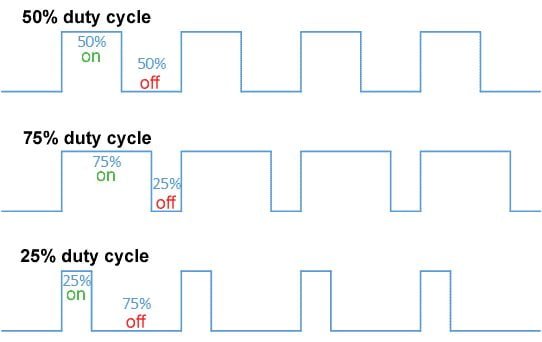
Heat management is critical for LED performance, as excessive heat can lead to reduced light output, color shifting, and shorter fixture lifespans. Traditional dimming methods, analog or resistor-based, can generate significant heat due to how they control current flow. This heat buildup can damage LED components and lower overall efficiency.
PWM dimming, however, dramatically improves heat management. PWM minimizes the heat generated during operation by quickly switching the LED on and off instead of continuously reducing current. Since the LED is fully on when active, it operates within its optimal temperature range. The short off-cycles allow the LED to dissipate heat more effectively, maintaining a stable operating temperature.
The result is reduced thermal stress on the LED and its components, ensuring stable performance over time. For environments where lighting needs to be on for extended periods, such as warehouses, offices, or outdoor spaces, PWM’s abPWM’s to manage PWM’s siPWM’scant advantage improves both performance and longevity.
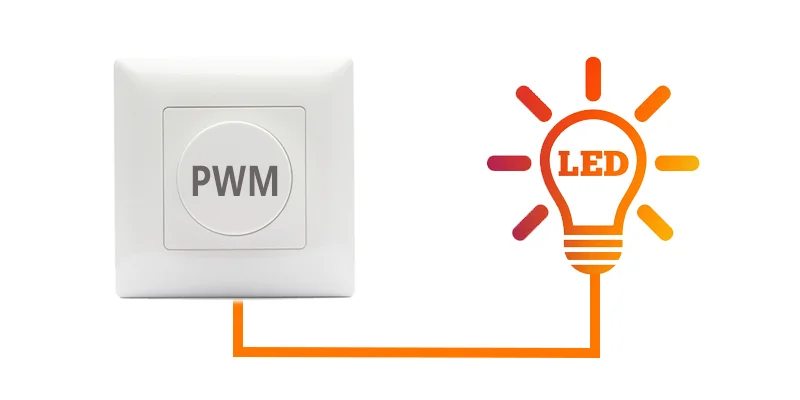
The way LEDs are dimmed has a direct impact on their lifespan. LEDs are known for their long operational life, often lasting tens of thousands of hours when correctly managed. However, the wrong dimming technique can reduce this lifespan by causing excess heat, current surges, or unstable operation.
PWM dimming extends the lifespan of LED fixtures by ensuring optimal performance under various lighting conditions. Because PWM dimming maintains a constant current to the LED and only adjusts the duty cycle, it prevents the wear and tear associated with fluctuating or reduced currents in analog dimming. The rapid on-off cycling reduces the average power load on the LED, resulting in less stress on the lighting components.
Moreover, as mentioned earlier, the improved heat management from PWM dimming further contributes to an extended lifespan by preventing overheating and reducing the risk of thermal degradation. With PWM dimming, LEDs can consistently achieve their maximum rated lifespan, providing long-term cost savings in replacement and maintenance.
Color fidelity refers to an LED’s ability to maintain a temperature across varying brightness levels. One of the main issues with analog or linear dimming is that as the current decreases, the LED’s coLED’semperatures shift, resulting in a warmer or less accurate hue at lower brightness. This color shift can be undesirable in settings where consistent lighting quality is crucial, such as retail displays, photography studios, architectural lighting, and medical facilities.
PWM dimming, however, excels in maintaining consistent color fidelity across the entire dimming range. Because PWM controls brightness by altering the duty cycle rather than changing the current, the LED always operates at its optimal current when it is “on.” The “s e”sures thet” the” li”ht “output retains its intended color temperature, regardless of the brightness level. The result is consistent color quality, whether the LED is at full brightness or dimmed to a lower level.
For applications where color accuracy and light quality are paramount, such as in restaurants, high-end retail stores, art galleries, and film production, PWM dimming is an invaluable solution for ensuring that LED lighting provides a uniform and pleasant color experience.
In summary, PWM dimming offers multiple benefits that make it the preferred choice for controlling LED lighting:
These advantages make PWM dimming highly suitable for various applications, from residential and commercial settings to industrial and specialty lighting environments. The precise control, energy savings, and color stability PWM dimming provides can transform the lighting experience, enhancing any space’s space’s ambiance and functionality.
In the following sections, we’ll examine how PWM we’ll be implemented in practical applications and how you can select the right LED solutions for your needs. For reliable, high-quality LED lighting that fully utilizes PWM dimming technology, you can explore the vast array of options offered by MyLikeLed.
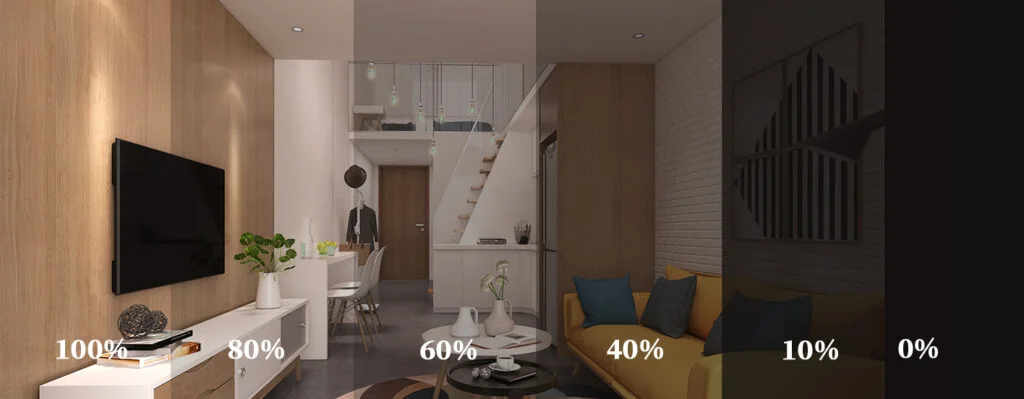
PWM dimming is a versatile technology with applications across a broad spectrum of lighting needs. Its ability to provide precise brightness control, energy efficiency, and consistent color fidelity makes it suitable for various environments, from homes to commercial spaces and specialized industries. Let’s expert’s how PWM Let’sng Let’sng in some key settings:
Lighting serves multiple purposes in homes, from general illumination to task lighting and ambiance creation. PWM dimming is an excellent choice for residential lighting because it offers smooth, flicker-free control over LED brightness, enabling homeowners to adjust the lighting to match their needs and moods.
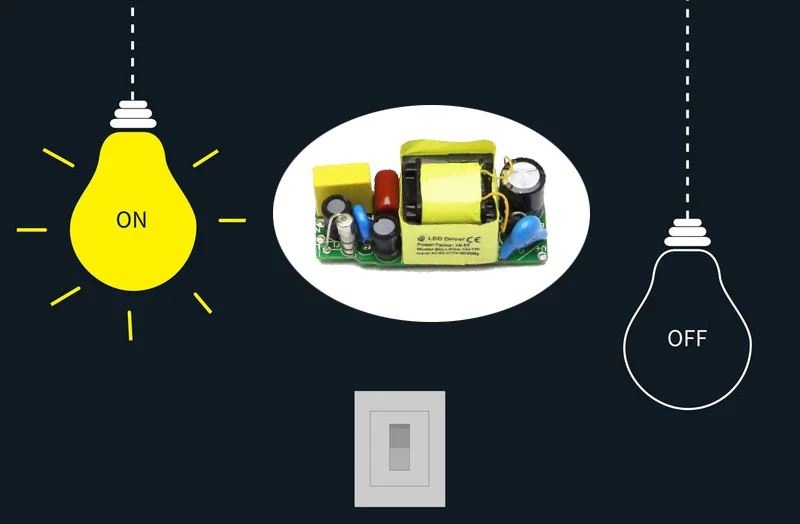
Commercial spaces require functional, efficient, and aesthetically pleasing lighting, and PWM dimming is widely used in settings such as offices, retail stores, restaurants, and hospitality venues.

Automotive lighting is another significant application of PWM dimming, where precision and control are essential for safety, aesthetics, and functionality. PWM dimming provides drivers and manufacturers with versatile lighting solutions for interior cabin lighting or exterior headlights.
In film, theater, and stage lighting, precise control over lighting is critical for creating visual effects, mood, and focus. PWM dimming is the technology used to control professional LED fixtures in these environments.
Implementing PWM dimming requires hardware and software components to create a seamless and efficient lighting control system. Understanding the essential elements and considerations in setting up PWM dimming can help ensure your LED lighting system performs optimally. Below, we dive into the leading technologies and design considerations for effectively implementing PWM dimming.
Specific hardware components are necessary to generate and control the PWM signal to achieve PWM dimming. These include controllers, LED drivers, and additional components that support reliable signal transmission.
Controllers are responsible for generating the PWM signal that dictates the brightness level of the LED. They adjust the duty cycle of the signal based on the desired dimming level, and this duty cycle is then sent to the LED driver, which regulates the LED’s beloved’s. SeveraLESeveraLED’sesrollers can be used for PWM dimming:
LED drivers play a critical role in the functioning of PWM dimming systems. The driver is responsible for converting the PWM signal into a format that can control the LED’s output. ThLED’srThLED’srent types of LED drivers suited to various PWM dimming applications:
While hardware components are essential for generating and managing PWM signals, software control allows for advanced customization and intelligent operation of the dimming system. Software control enables features such as:
Proper design and planning are critical for successfully implementing PWM dimming in any environment. The following considerations are crucial to ensuring optimal performance:
The frequency at which the PWM signal oscillates (turns on and off) plays a vital role in dimming performance. Frequencies above 100Hz are typically used to prevent visible flicker, but higher frequencies—often 500Hz to 1kHz or more—are preferred to ensure smooth and flicker-free operation. Care must be taken to select a frequency that balances performance and avoids potential interference with other electronics.
The dimming range (the lowest and highest brightness levels achievable) and the resolution (the number of brightness steps) are essential factors to consider. High-resolution dimming allows fine control over brightness, which is particularly important for environments requiring subtle adjustments or mood lighting. A typical high-resolution PWM dimmer might have 8-bit (256 levels), 10-bit (1024 levels), or higher resolution.
Since LEDs generate heat, proper thermal management is necessary to maintain performance and extend the lifespan of the lighting fixtures. PWM dimming helps reduce heat generation by maintaining efficient “on” Ttims, “but additional”na” des” gn” elements like heat sinks or ventilation should be incorporated into the lighting fixture to ensure adequate cooling.
It’s important to ensure the dimming system is compatible with existing lighting infrastructure and control systems. For example, retrofitting an existing space with PWM-dimmable LEDs may require additional considerations, such as replacing old dimming switches with compatible controllers or drivers. Additionally, if integrating with smart home systems, ensure that the PWM dimming setup works with the preferred control protocols and automation platforms.
PWM dimming generates high-frequency signals, sometimes producing electromagnetic interference (EMI) that could affect nearby electronics. To mitigate this, proper shielding, grounding, and filtering techniques should be employed in the design of the dimming system.
Building an efficient and reliable PWM dimming system involves carefully combining hardware components, software control, and design considerations. From choosing the suitable controller and LED driver to programming software for intelligent control and designing the system for optimal performance, every step is crucial for achieving smooth, flicker-free dimming and consistent light quality.
For anyone looking to implement high-quality PWM dimming in their lighting setup, it’s important to chooit’schooit’somponentsducts that align with the application’s needs. At MyLikeLed, you can find advanced LED products and dimming solutions designed to help you achieve precise control, energy savings, and enhanced lighting performance across residential, commercial, automotive, and other specialized environments.
While PWM dimming offers numerous advantages, some challenges must be addressed for smooth and effective operation. Factors like flicker, compatibility issues, and system performance need careful attention to ensure an optimal experience. Below, we explore the common challenges associated with PWM dimming and discuss practical solutions and best practices to overcome them.
One of the most common challenges faced in PWM dimming is flicker. Flicker occurs when the LED switches on and off at a rate that is detectable to the human eye or sensitive devices like cameras. While high-frequency PWM signals typically prevent visible flicker, improper implementation can still lead to problematic flickering, which can have negative consequences.
Solutions to Address Flicker:
Compatibility issues can arise when integrating PWM dimming with existing lighting systems, power supplies, or intelligent control protocols. These challenges can impact the dimming system and usability.
Solutions to Compatibility Challenges:
To ensure the smooth and efficient operation of a PWM dimming system, it’s important to follow the steps in follit’ sertainactices that help address potential challenges and enhance system performance.
Since PWM dimming operates at high frequencies, there’s a lack of electromagnetic interference (EMI) that can affect nearby electronic devices. To prevent EMI:
LEDs generate heat during operation, and efficient heat management is crucial for maintaining performance and lifespan. When designing a PWM dimming system:
To create an optimal lighting experience, it’s important to ensure gradual:
While challenges such as flicker, compatibility, and heat management exist in PWM dimming systems, these issues can be effectively managed through careful design, component selection, and adherence to best practices. You can create a highly efficient, comfortable, and reliable LED dimming system by optimizing the PWM frequency, ensuring component compatibility, and maintaining proper heat and EMI management.
With these solutions, PWM dimming can precisely control LED brightness, offering energy efficiency, extended fixture lifespan, and consistent color fidelity. When seeking the best components and guidance for PWM dimming systems, exploring the product range and expertise available at MyLikeLed can help you find the ideal solutions for your lighting needs.
As LED lighting technology continues to evolve, PWM dimming is expected to become even more advanced and integrated into our daily lives. From enhanced performance to seamless integration with smart home and IoT (Internet of Things) ecosystems, the future of PWM dimming holds exciting possibilities. Let’s exLet’s some of Let’smerLet’smergemergingndal advancements in this field.
The technology behind PWM dimming is constantly improving, and several innovations are expected to enhance its performance, efficiency, and capabilities.
The integration of PWM dimming into smart homes and IoT systems represents one of the most significant trends for the future. With the growing popularity of connected devices and innovative technologies, PWM dimming will be crucial in creating intelligent lighting systems that enhance user convenience, efficiency, and personalization.
As the demand for efficient and controllable lighting grows, the market for PWM dimming systems is expected to expand across various sectors and applications. Several emerging trends will shape the future use of PWM dimming in residential and commercial settings.
The future outlook for PWM dimming is promising, with technological advancements driving improvements in energy efficiency, user experience, and integration with intelligent systems. As LED lighting becomes more sophisticated, the ability to precisely control brightness and adapt to various conditions will enhance the way we use and interact with lighting daily.
From smart homes to smart cities, PWM dimming will continue to play a pivotal role in shaping the lighting industry, offering solutions that are functional but also sustainable and personalized. As the technology evolves, the applications for PWM dimming will only expand, providing endless possibilities for residential and commercial users to create intelligent, efficient, and dynamic lighting environments.
PWM dimming has emerged as a game-changing technology in LED lighting, offering precise control over brightness, energy efficiency, and consistent color fidelity. By rapidly switching LEDs on and off, PWM dimming enables smooth and flicker-free dimming across various applications, from residential spaces and commercial buildings to automotive and entertainment lighting. It overcomes many challenges associated with traditional dimming methods, such as color temperature shifts and inefficiency, making it the preferred choice for modern lighting control systems.
The versatility and benefits of PWM dimming extend beyond simple brightness adjustment. Its integration into smart home systems, IoT networks, and adaptive lighting environments positions PWM dimming as a core technology for enhancing user experience, energy management, and sustainability. As advancements in PWM dimming technology continue to evolve—such as higher-frequency dimming, software-controlled customization, and compatibility with intelligent ecosystems—the applications for this technology will only grow.
Whether you are a homeowner looking to create the perfect ambiance, a business seeking energy-efficient lighting solutions, or a designer aiming to implement dynamic and responsive lighting, PWM dimming provides a powerful and flexible tool to meet those needs. With the continuous developments in the field, there is ample opportunity for further exploration and application of PWM dimming to create innovative lighting solutions that improve comfort, productivity, and overall well-being.
For those seeking to take advantage of the latest advancements in LED lighting, considering PWM dimming and its various applications is a step towards more efficient and dynamic lighting control. Explore the diverse range of LED products and dimming solutions MyLikeLed offers to transform your spaces with modern, high-performance lighting.

We understand that every project is unique. That’s why we offer tailored LED strip solutions to meet your specific requirements.
Copyright © 2024 – My Like Led All rights reserved.
Let's have a chat